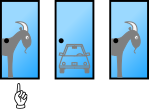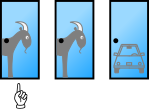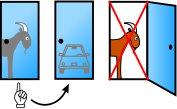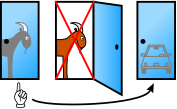Note that the player may initially choose any of the three doors (not just Door 1), that the host opens a different door revealing a goat (not necessarily Door 3), and that he gives the player a second choice between the two remaining unopened doors.
Solution
The overall probability of winning by switching is determined by the location of the car. According to the problem statement above, a car and two goats are arranged behind three doors and then the player initially picks a door. Assuming the player's initial pick is Door 1 (the same analysis applies for any other door the player picks):
- The player originally picked the door hiding the car. The game host must open one of the two remaining doors randomly.
- The car is behind Door 2 and the host must open Door 3.
- The car is behind Door 3 and the host must open Door 2.
Players who choose to switch win if the car is behind either of the two unchosen doors rather than the one that was originally picked. In two cases with 1/3 probability switching wins, so the overall probability of winning by switching is 2/3 as shown in the diagram below. In other words, there is a 2/3 chance of being wrong initially, and thus a 2/3 chance of being right when changing to the other door.
Source :
http://en.wikipedia.org/wiki/Monty_Hall_problem
Krauss, Stefan and Wang, X. T. (2003). "The Psychology of the Monty Hall Problem: Discovering Psychological Mechanisms for Solving a Tenacious Brain Teaser," Journal of Experimental Psychology: General 132(1). Retrieved from http://www.usd.edu/~xtwang/Papers/MontyHallPaper.pdf March 30, 2008.







No comments:
Post a Comment